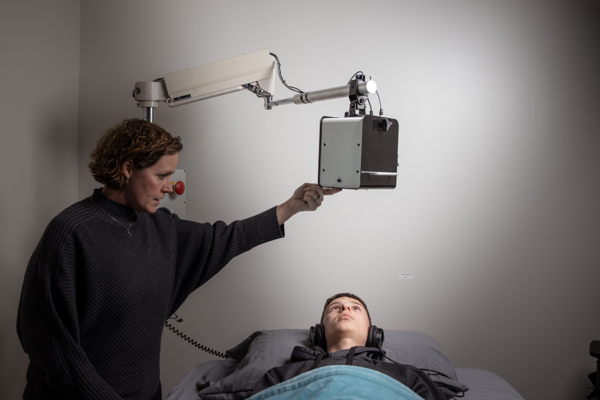OMST is a passive therapy, meaning the patient does not have to engage in an exercise and the outcome is not dependent on their input. OMST is designed to help the brain learn or relearn multisensory processing and filtering.
Academy of Vision Development’s bottom-up (subcortical) approach to therapy is designed to help patients be more calm, confident, coordinated, and attentive in their environment. This enables them to fully engage at home, school, social encounters, tutoring, and during Optometric Vision Therapy.

How does It Work?
The brain develops from the bottom up, therefore the first step of learning for every child is sensory processing. In order to filter out unimportant information we all must learn to modulate and integrate the multiple neuro-sensory inputs our brain receives from the environment. Sensory processing develops in the brainstem as a subcortical skill and should be fully learned by age three. If these sensory processing skills are not learned or there is damage to the brain, OMST passively integrates these skills in a safe, controlled environment.
The next steps of learning – movement, balance, behavior, speech, and cognition are dependent on having well-established, efficient multi-sensory processing and filtering. When a child fails to properly develop a firm foundation for sensory processing, they struggle with reaching their full potential. Whether sensory processing never developed or they were injured, OMST is a bottom-up therapy that subcortically and passively integrates these senses. Having sensory processing on autopilot allows for higher brain function. OMST teaches/reteaches patients the subconscious skill of multi-sensory filtering and processing in a safe and controlled clinical setting.
“One of the most important functions of our brain is to integrate the information from all our senses into a perceptual whole. Only then can we perceive the world as single, integrated, and stable. Brain injury shatters this.”
– Dr. Sue Barry (author of Fixing My Gaze).
“After going through OMST I saw results in better balance, decreased blurring and double vision, and an increased ability to read. I also saw an increase in peripheral awareness and duration of focus. These changes resulted in a decreased need for using a cane for balance, ability to resume driving, and return to work.”
– Judy S. (Nurse Manager, Ohio Health)
92% of parents whose children completed Optometric Multi-Sensory Training felt the program helped their children.
Diagnosis’ that VT and/or OMST can help with:
- ADD/ADHD
- Amblyopia
- Autism
- Developmental Delays
- Concussion
- Traumatic Brain Injury
- Convergence Insufficiency
- Double Vision
- Poor Tracking Skills
- Sports Performance
- Strabismus
- Crossed-Eyes
- Reading Comprehension
- Motor Skills
- Sensory Processing Disorders
- Retained Primitive Reflexes
- Reading Speed
- Reading Fluency
OMST Success Stories
“My headaches are gone and I was able to be in the room with lights on. I’m able to sleep and my mind is clearer, it was so foggy before.” (Concussion Patient)
Mom stated, “She’s sleeping better, following directions easier, and small issues that used to lead to rages now blow over without much issue.”
"(During OMST) she went to bed beautifully and right to sleep”
“Seems easily triggered immediately after the table but listens better without arguments.”
“Eliora just did ALL her schoolwork without any complaining in 1 hour!”
“She wanted to read a book before bed, that has never happened before! She goes to bed easier and falls asleep without struggle.”
“Amelia is reading! She’s also so much better at regulating her emotions. Things that used to make her melt down are not triggering anymore.”
“We always have to give numerous warnings when we are leaving the house, transitions are not easy for Dylan, and planning ahead or thinking about others is not something he does. Tonight, I gave him a 10min warning and he disappeared downstairs. I knew it was going to be a struggle, but to my surprise, he came back up with his shoes! I about fell over, but then he asked me if we needed Alexa for the dog (we play music on Alexa when we leave the house to keep the dog company). Not only did he plan for himself to leave the house, he also thought about what the dog needed!!!”
“Last night he asked for his iPad and when we told him no, he asked his sister to put hers away because it wasn’t fair he couldn’t have his out. For him to express this verbally instead of getting angry is a big step.”
“He was so chill last night! He asked for his iPad and video games a few times but I told him he couldn’t. He didn’t argue or anything! He went outside and played hockey instead. When I called him in, he didn’t complain and came in right away!!”
